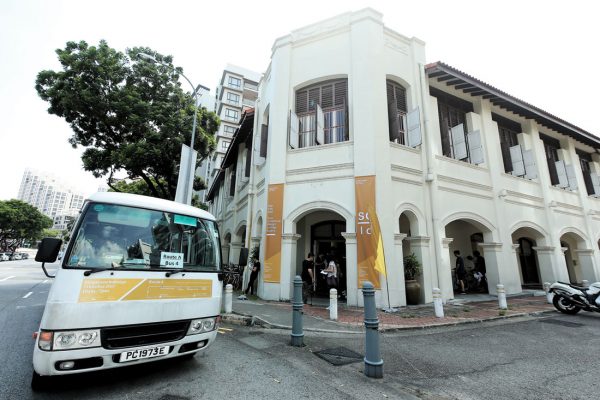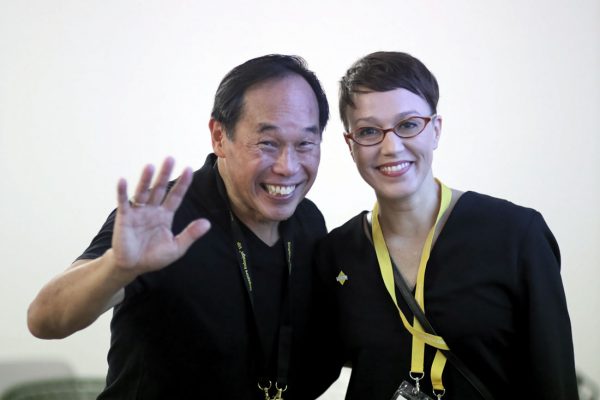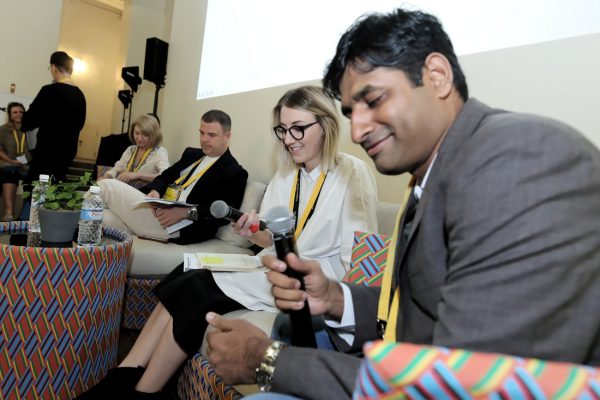Our popular #SGID Design Conversations series and our new #SGID Insights sessions converged this year in a workplace knowledge fest! What did we learn?

October 20th, 2017
We kicked off #SGID17 bright and early this year with two discussion sessions dedicated to workplace design. Over breakfast at the Curated Space at Mohamed Sultan Road, we looked back and forward in time at some of the key issues around workplace design.

In the first of our #SGID Insights sessions, I asked Steven Louie to recall his experience of how workplace design has evolved through the years. Louie, who served as an #SGID17 Ambassador, recently joined Geyer Singapore as the studio’s Workplace Leader Asia. He has over 40 years experience in the strategic planning, design and delivery of interior projects globally across Asia, Europe and the US.
That experience formed the basis of an illuminating discussion about how the currents of workplace design have shifted – from the days of the arrival of multinational companies in Asia, to the converging of cultures in Asia’s workplaces today.

Then our gaze turned to the future with the first of this year’s Design Conversations. Our stellar panel of workplace specialists consisted of Dr Caroline Burns (Managing Director and Founder, Workplace Revolution), Shobhit Choubey (Director and Head of Workplace Strategies SEA, CBRE), Katie O’Brien (Senior Interior Designer, Gensler Tokyo) and Paul Semple (Principal, HASSELL).
Their topic: ‘How Can We Future-Proof the Workplace Against Uncertainty?’ We do like to ask the hard questions!
The discussion centred on the fact that now, more than ever before, organisations require adaptability to volatile, unpredictable conditions. But if change in business is unpredictable, how on earth can the workplace designer create a space that will be relevant three years – even three months – after completion?

As you might expect, co-working was raised several times. “Co-working as a real estate value proposition for corporate clients is becoming very attractive going forward,” said Choubey. “Co-working is definitely going to be one of the important variables in how not only start-ups and small firms see their occupancy requirements, but also large clients. And now we’re seeing that joint ventures between co-working operators and large developers are also on the cards.”
Co-working venues offer workplace as a service – like the membership of a club, suggested Burns. “Co-working will continue to grow but in many different forms,” she said. Hackable spaces that can be reconfigured by users are another solution to uncertainty, said O’Brien.
Semple and O’Brien discussed the strategic frameworks that HASSELL and Gensler have developed: RAW (Responsive Agile Workplace) and WPI (Workplace Performance Index) respectively. Explained Semple, “The premise of RAW is this circular notion around researching, testing, realising. There’s so much information that’s available to us now. RAW was set up to understand how best to use this information to develop environments that work now but have a programme that allows continuing engagement.”
O’Brien explained how Gensler uses its WPI online survey to gather quantitative and qualitative data on “how people work, the spaces they use to work, and how well those spaces are actually working when they’re in them.”
Designers’ strategies aside, how are clients doing with attempts to predict their needs in the future? Badly, said both Choubey and Burns. “Are all these jobs going to stay in this location? Are other parts of the business going to move into Singapore? Is that going to change head count? What impact is AI going to have? A lot of it is trying to ask the right questions and get some kind of paradigm around what the risks of growth and reduction are, and then try and build sufficient flexibility for the organisation,” said Burns.
She added, “I think more and more we might be called upon to design spaces as part of buildings or campuses that are not owned by a particular organisation, but they’re accessed by different organisations.”
We ended with the panel’s thoughts on what will be the key foundations of the workplace of the future: change resilience, culture, porosity and human beings.
Photography by Wilson Pang.
INDESIGN is on instagram
Follow @indesignlive
A searchable and comprehensive guide for specifying leading products and their suppliers
Keep up to date with the latest and greatest from our industry BFF's!

To honour Chef James Won’s appointment as Gaggenau’s first Malaysian Culinary Partner, we asked the gastronomic luminaire about parallels between Gaggenau’s ethos and his own practice, his multidimensional vision of Modern Malaysian – and how his early experiences of KFC’s accessible, bold flavours influenced his concept of fine dining.

Gaggenau’s understated appliance fuses a carefully calibrated aesthetic of deliberate subtraction with an intuitive dynamism of culinary fluidity, unveiling a delightfully unrestricted spectrum of high-performing creativity.

BLANCOCULINA-S II Sensor promotes water efficiency and reduces waste, representing a leap forward in faucet technology.

In this candid interview, the culinary mastermind behind Singapore’s Nouri and Appetite talks about food as an act of human connection that transcends borders and accolades, the crucial role of technology in preserving its unifying power, and finding a kindred spirit in Gaggenau’s reverence for tradition and relentless pursuit of innovation.

The Finding Infinity Principal comments here on the question of balance in city life, with architecture and design highlighted as the key levers for making change.

The Hub, Australia’s largest private workspace operator, has 16 locations across the country. Their newest site – designed by Architectus and Hassell – puts Perth’s unique context front and centre.

In Cremorne, Foolscap Studio has completed Forum – a co-working space that finds inspiration in some Classical archetypes.

How can design empower the individual in a workplace transforming from a place to an activity? Here, Design Director Joel Sampson reveals how prioritising human needs – including agency, privacy, pause and connection – and leveraging responsive spatial solutions like the Herman Miller Bay Work Pod is key to crafting engaging and radically inclusive hybrid environments.
The internet never sleeps! Here's the stuff you might have missed

His name is revered and his work acclaimed, and John Wardle continues to make his presence felt on the built landscape of Australia like no other.

An exhibition titled ‘Synthetic Spaces’ by Maycon Sedrez and Gregory Pitts from Deakin University is taking place at the Bates Smart Gallery in Melbourne.